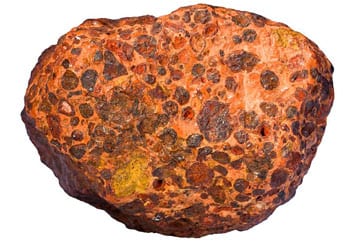Seleccione Idioma da:
O aluminio é o elemento metálico máis común atopar na Terra, totaling about 8% da codia da Terra. con todo, aluminum as an element is reactive and therefore does not occur naturally – it needs to be refined to produce aluminum metal. O material de partida principal para a refinación de aluminio é a bauxite, principal fonte comercial do mundo de aluminio. Bauxite is a sedimentary rock, and consists mostly of the aluminium minerals gibbsite (Al(OH)3), boemita (C-alo(OH)) e diaspore (un-alo(OH)), and is usually mixed with the two iron oxides goethite and hematite, the aluminium clay mineral kaolinite and small amounts of anatase (TiO2) and/or ilmenite (FeTiO3).

depósitos de bauxita están espallados en todo o mundo, que se produce principalmente en rexións tropicais ou subtropicais. Although proven reserves of bauxite are expected to last for many years, a calidade das reservas que poden ser economicamente accesibles está en declive. para as refinerías, who are in the business of bauxite processing to make alumina, e, finalmente, de metal de aluminio, este é un reto con ambas as implicacións financeiras e ambientais.
The process to refine metallurgical bauxite into alumina involves the following inputs:
The following outputs are generated:

The most widely used chemical process of refining bauxite into alumina, o proceso de Bayer, involves dissolving the Al2O3 out of the bauxite rock with caustic soda (NaOH) at elevated temperature and pressure. The Al2O3 fraction of the bauxite is dissolved into solution, to later be precipitated out as alumina. con todo, a high-grade bauxite contains up to 60% Al2O3, and many operating bauxite deposits are well below this, en ocasións, tan baixo como 30-40% Al2O3. Because the desired product is a high purity Al2O3, os óxidos remanentes na bauxita (Fe2O3, SiO2, TiO2, Organic material) are separated from the Al2O3 and rejected as alumina refinery resides (ARR) or red mud. En xeral, a calidade inferior da bauxita (ie lower Al2O3 content) the more red mud is generated per ton of alumina product. Ademáis, even some Al2O3 bearing minerals, nomeadamente caulinita, produce un-desirable side reactions during the refining process and lead to an increase in red mud generation, así como unha perda de caro química sosa cáustica, un gran custo variable no proceso de refino de bauxita.
barro ou ARR vermello representa unha grande e permanente desafío para a industria de aluminio. A Lama vermella contén cáustica residual resto química significativa do proceso de refino, e é altamente alcalino, moitas veces con un pH 10 - 13. It is generated in large volumes worldwide – according to the USGS, estimou a produción mundial de alúmina foi 121 millóns de toneladas en 2016. This likely resulted in more than 150 millóns de toneladas de lodo vermello xerada durante o mesmo período. Aínda investigación en curso, lama vermella ten actualmente uns camiños comercialmente viables para re-utilización benéfica. Estímase que moi pouco de barro vermello é beneficiosa reutilizados en todo o mundo. Instead the red mud is pumped from the alumina refinery into storage impoundments or landfills, onde se garda e monitor polo gran custo.
A perda de caro sosa cáustica (NaOH) and the generation of red mud are both related to the quality of the bauxite used in the refining process. En xeral, the lower the Al2O3 content of the bauxite, canto maior sexa o volume de lama vermella que será xerado, as the non-Al2O3 phases are rejected as red mud. Ademáis, the higher the kaolinite or reactive silica content of the bauxite, a lama máis vermello xerarase. The reactive silica content not only increases the volume of red mud, but also consumes caustic soda reagent and reduces the yield of Al2O3 recovered from the bauxite. polo tanto, there is both an economic and environmental argument to be made for improving the quality of bauxite prior to refining.
As ofertas de proceso STET seco separación bauxita produtores ou refinados de bauxita unha oportunidade para realizar a actualización de pre-Bayer proceso de mineral de bauxita para mellorar a calidade. Esta visión ten moitos beneficios:
En resumo, procesamento en seco coas oportunidades ofertas de separación STET para xerar valor para os produtores e refinados de bauxita. O pre-procesamento de bauxita antes da refinación vai reducir os custos químicos, diminuír o volume de lama vermella xerada e minimizar trastornos do proceso.
Referencias: